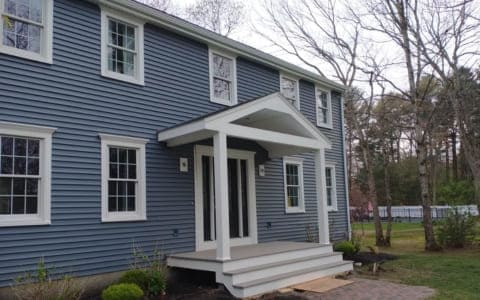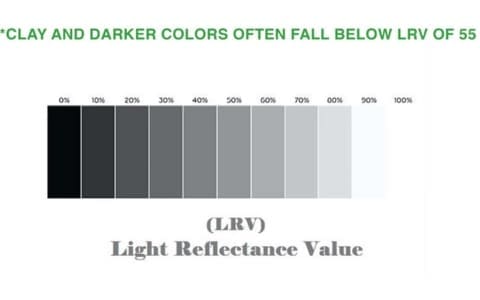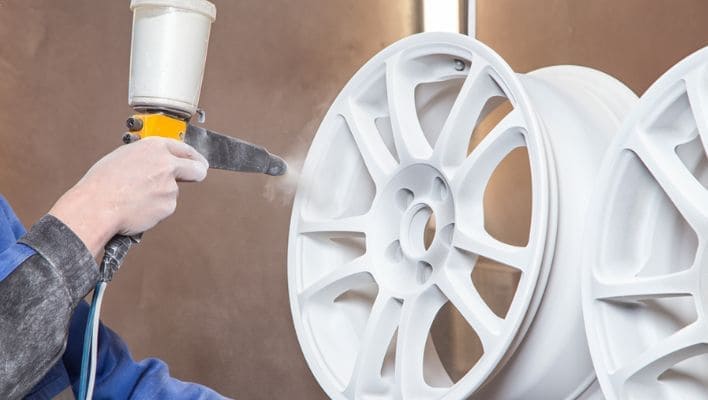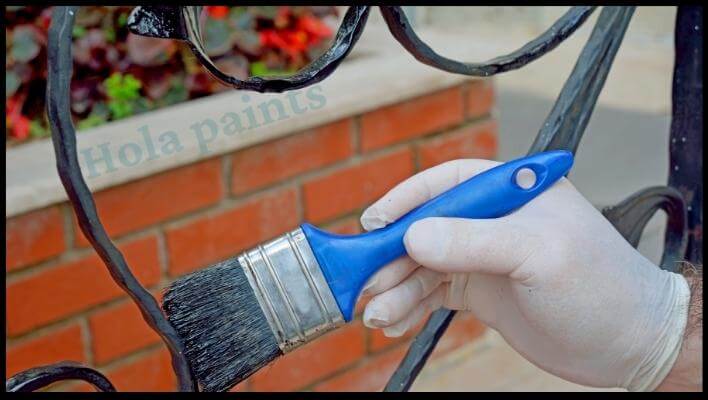PVC trim is well-liked in construction and home improvement for being strong and easy to take care of. However, if you’re looking to refresh the appearance of it, you may wonder, Can You Paint PVC Trim?
The good news is yes, you can!
So, if you want to add some color to your polyvinyl chloride trim, you totally can with the right steps and materials. This article will show you how to paint PVC trim in a simple way to make sure your painted PVC trim looks good and lasts a long time.

Table of Contents
- How To Paint PVC Trim?
- Choosing the Right Paint:
- Surface Preparation:
- Priming the PVC Trim:
- Painting the PVC Trim:
- Sealing the Paint:
- Maintenance Tips:
- What is PVC Trim?
- Pros of Painting PVC:
- Cons of Painting PVC:
- FAQS
- Which Paints Are Best for PVC Trim?
- What paint will stick to PVC plastic?
- Can you leave PVC trim unpainted?
- How long does painted PVC trim last?
- Is PVC trim the same as AZEK?
- Conclusion:
- Martina Hitchcock
How To Paint PVC Trim?
Painting PVC trim is super easy, if you follow these steps which are mentioned below.
Choosing the Right Paint:
Select light color acrylic latex paint (100%) when painting PVC trim, as it adheres well to plastic surfaces and can withstand temperature changes.

Surface Preparation:
You should thoroughly clean the PVC trim with a mild detergent solution and a soft brush or sponge. I have also tried clean magic erasers to clean it and its pretty good!
For glossy surfaces, it’s advisable to lightly sand them using fine-grit sandpaper to achieve a slightly rough texture. This step is important for promoting better paint adherence.
Priming the PVC Trim:
Choose a primer that is compatible with acrylic latex paint, and carefully follow the manufacturer’s instructions for drying times.
Painting the PVC Trim:
Once the primer is fully dried, apply a high-quality acrylic latex paint in your preferred color. Apply the paint using a brush, roller, or spray, employing long, even strokes to achieve a smooth and professional finish. Ensure each coat dries thoroughly before applying additional coats, adhering to the suggested drying times for optimal results.
Sealing the Paint:
Consider applying a clear sealant or topcoat designed for exterior use to protect the painted surface from the elements, UV rays, and other environmental factors.
My project;
I took on a home improvement project recently where I tackled some weather-beaten white cedar shingles. They were in pretty bad shape, so I decided to replace them. I also swapped out some worn-out trim with sturdy PVC trim boards for a fresh look. Instead of going for the traditional route, I opted for a modern touch by installing a light grey vinyl cedar impression material for the siding. It not only refreshed the appearance but also comes with the added bonus of no more painting headaches for the homeowner. The end result? Here it is;

The house still rocks the same classic charm, but with a durable and low-maintenance makeover. Super pleased with how it turned out!
Maintenance Tips:
Although PVC trim is known for being low maintenance, painted surfaces may require occasional touch-ups over the years. Keep an eye out for any chipping or peeling, and address it promptly to maintain the trim’s appearance.
What is PVC Trim?
PVC trim is a synthetic material used in construction as a substitute for wood. It is made from polyvinyl chloride and is favored by builders for trim work due to its moldable nature, similar to wood. PVC trim offers excellent moisture resistance, making it a durable option for a variety of projects.
Pros of Painting PVC:
- PVC trim is resistant to moisture, unlike wood, making it less susceptible to damage and rot caused by water.
- The plastic material of PVC is easy to manipulate and mold, especially around challenging corners of a house.
- Unlike wood, PVC trim won’t warp, split, or promote mold growth, offering a more resilient option.
- PVC is typically more cost-effective than wood, providing a budget-friendly choice in the long term.
- Painting PVC allows for customization of colors to match preferences or the overall design of a space.
- Some paints with UV-resistant properties can shield PVC from sunlight, preventing discoloration and degradation.
- Paint acts as a protective layer, guarding PVC against scratches, stains, and various damages.
Cons of Painting PVC:
- PVC is more prone to breakage, especially during installation, requiring careful handling.
- While PVC is cost-effective in the long term, there might be a higher initial cost during installation. However, its durability reduces the need for future maintenance.
- Painting PVC can be challenging due to its smooth surface, requiring proper preparation to avoid issues like peeling or chipping.
- PVC expands and contracts with temperature changes, and if the paint isn’t flexible enough, it may crack as the PVC moves.
- Achieving a good paint job on PVC demands thorough cleaning, sanding, and, at times, the use of primers to ensure proper adhesion.
FAQS
Which Paints Are Best for PVC Trim?
When painting PVC trim, use water-based acrylic latex paints designed for plastic surfaces. Avoid oil-based paints, choose lighter colors to minimize heat absorption, and apply a PVC primer for better adhesion. Start by cleaning the surface and apply thin coats of the material. This ensures a flexible, durable finish that accommodates PVC’s natural expansion and contraction.
What paint will stick to PVC plastic?
To paint PVC plastic effectively, use Zinsser’s Bulls Eye 1-2-3 primer for its strong adhesion to the smooth surface. Opt for Krylon Fusion paints designed for plastic, as they offer a durable finish, reducing the risk of chipping or peeling. These paints are formulated specifically for plastic surfaces, ensuring a lasting and quality result.
Can you leave PVC trim unpainted?
Choosing lighter colors for PVC trim is wise due to thermal expansion. One thing I like the most about PVC trim is a sturdy plastic material used in construction. It lasts well and doesn’t get damaged easily by moisture. That’s because it comes loaded with UV-resistant additives during manufacturing, ensuring its color lasts a long time.
How long does painted PVC trim last?
Painted PVC trim can endure for 20 to 25 years, surpassing the performance of materials like wood. Unlike wood with a 6% moisture allowance requiring repainting every three to five years, cellular PVC exhibits superior paint adhesion. When the appropriate paint is selected, and the PVC is properly prepared through cleaning, sanding, and priming, it can maintain its painted finish for two to two-and-a-half decades without the need for repainting, providing a long-lasting and low-maintenance solution for exterior trim applications.
Is PVC trim the same as AZEK?
PVC trim and AZEK are related, but they’re not exactly the same. PVC trim is a strong plastic material that lasts and doesn’t get damaged by moisture. AZEK is a brand that makes cellular PVC trim. “Cellular” means it has a foamed or porous core, making it lighter without sacrificing strength. So, PVC trim is a general term, when people mention AZEK trim, they’re often talking about trim made by the AZEK brand using cellular PVC.
AZEK suggests using Sherwin Williams Emerald Exterior Acrylic Latex, Duration, Exterior Acrylic Latex, and Resilience Exterior Acrylic Latex for painting outdoor surfaces. These 100% acrylic latex paints are recommended by AZEK for their exterior applications.
Conclusion:
In conclusion, painting PVC trim offers a practical solution to enhance both aesthetics and durability. Choosing an appropriate, high-quality exterior latex paint designed for PVC, coupled with proper cleaning and priming, ensures a lasting and visually pleasing result. While PVC inherently resists various environmental factors, such as moisture and insects, painting adds an extra layer of protection, especially against UV rays. Following manufacturer guidelines is important for optimal outcomes, making it an accessible and cost-effective option for homeowners and builders seeking a customized and resilient trim that complements their overall design vision.

Martina Hitchcock
Martina Hitchcock is a versatile author with expertise in different fields. As a paint sprayer expert, she has in-depth knowledge of paint spraying techniques, tools, and equipment. Martina is also an experienced home remodeler who has worked on various projects, including kitchen and bathroom renovations, flooring installations, and room additions. Her knowledge of home improvement and remodeling is extensive, and she enjoys sharing her insights and tips with readers. You can follow her on Facebook.


